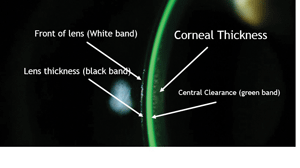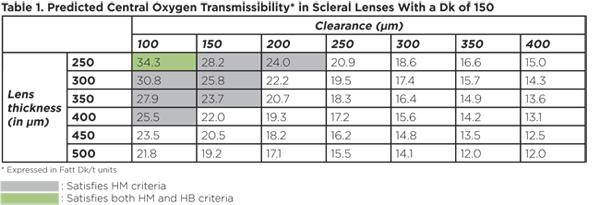 Do you have a patient whose superficial punctate keratitis (SPK) persists no matter how many eye drops and gels they use? How about a patient with dry eye symptoms who gets no relief from lid hygiene, artificial tears, Restasis—i.e., the works? Have you seen someone present with a recurrent corneal erosion that just won’t go away?
Do you have a patient whose superficial punctate keratitis (SPK) persists no matter how many eye drops and gels they use? How about a patient with dry eye symptoms who gets no relief from lid hygiene, artificial tears, Restasis—i.e., the works? Have you seen someone present with a recurrent corneal erosion that just won’t go away?
I’m sure the answer to each of those questions is yes. But I’ll bet you never imagined GP contacts could help with these conditions.
Traditionally, scleral contact lenses are reserved for irregular corneas; however, many doctors began taking advantage of the superior tear chamber clearance offered by the modality to help manage certain corneal problems (Figure 1). In fact, a number of conditions—depending on the cause—can be treated with a scleral contact lens:
•Acute or chronic SPK
•Filamentary keratitis
•Recurrent corneal erosion
•Large corneal abrasion
•Many forms of dry eye (e.g., evaporative, Sjögren’s, post-surgical), especially in patients unresponsive to palliative therapy.
•Incomplete blinkers
•Bell’s palsy
•Graft-vs.-host disease
Not Just for Irregular Corneas
Many of the patients who present with the aforementioned conditions are at the end of their rope. They are often extremely uncomfortable and experience poor quality of life. Despite our best efforts to treat our patients with severe dry eye, every practitioner sees a few of these patients who just never seem to find long-lasting relief from their symptoms.

| |
|
Fig. 1. The superior tear chamber clearance offered by scleral lenses allows practitioners to prescribe the modality to treat a number of corneal conditions.
|
A study published in the December 2007 Cornea involving 33 chronic graft-vs.-host disease patients with severe dry eye found that the Boston prosthesis (a type of scleral contact lens) resulted in the highest possible improvement in pain symptoms (52% of patients), photophobia (63%) and quality of life (73%).1 Scleral lenses had a tremendous impact on these patients!
So, how exactly can scleral lenses help these patients? The bowl of the scleral lens is usually filled with non-preserved saline and then placed on the eye with the patient’s chin tucked into their chest and facing the floor (Figure 2). Upon successful insertion, a layer of liquid rests between the anterior portion of the cornea and the posterior surface of the contact lens. This keeps the cornea moisturized by bathing it all day.
The scleral lens also prevents the eyelids from making contact with the cornea, which prevents disruption of the corneal epithelium. Because the scleral lens covers the entire corneal surface, even if the tear layer evaporates off the contact lens surface (e.g., as in evaporative dry eye patients, incomplete blinkers, etc.), the cornea remains unaffected.
 |
|
|
Fig. 2. The proper scleral lens insertion technique.
|
Extended Scleral Lens Wear
The key to delivering the highest amount of oxygen to the cornea is a high oxygen permeable material combined with a small amount of central clearance (Table 1).2 Research shows that the cornea does not receive much oxygen during scleral lens wear, and the modality is best suited to a daily-wear schedule—not worn on an extended basis.2 Patients with extreme dry eye or severe epithelial defects are the exception to this rule, however.1,3-4
One noteworthy study evaluating scleral lens extended wear in patients with persistent epithelial defects such as Stevens-Johnson syndrome found it effective in promoting the healing of persistent corneal epithelial defects in some eyes that failed to heal following other therapeutic measures.3,4 The healing response was attributed to a combination of oxygenation, moisture and protection of the corneal epithelium. Despite the positive healing effects, however, there was a significant risk of microbial keratitis; it was observed in 30% of the eyes wearing extended wear scleral lenses.
|
Clinical Pearl
| |
| Having your patients fill their scleral contact lenses with a "cocktail" of half non-preserved saline and half Celluvisc (a non-preserved, but more viscous, artificial tear) can also be a great option for those patients who are in need of even more lubrication. |
Although extended wear of scleral lenses is not the typical wearing schedule, in some cases it is necessary. Patients requiring extended wear should be monitored very closely, and prophylactic antibiotic drops may be considered.
Scleral lenses offer hope to patients with extreme dry eye symptoms who have seemingly reached a dead end with other treatment options. Several case reports and some solid evidence demonstrate that corneas can be healed and treated with scleral lenses.
Personally, I have successfully used scleral lenses to treat several patients who had corneal damage. Many of these patients were referred to me because their doctor had explored every other treatment option, yet the patient was still in pain and the cornea was left unhealed.
Scleral contacts can truly change someone’s life. Hopefully, in the future, they may be considered as one of our first treatment options to prevent needless suffering and wasteful trial-and-error attempts that ultimately lead to the same solution.
 |
1. Jacobs, D. et al. Boston Scleral Lens Prosthetic Device for Treatment of Severe Dry Eye in Chronic Graft-Versus-Host Disease. Cornea: Dec 2007, 26 (10). 1195-1199.
2. Michaud, L, et al. Predicting oxygen transmissibility for scleral lenses. Cont Lens Ant Eye. 2012 Dec;35(6):266-71.
3. Rosenthal, P, et al. Treatment of persistent corneal epithelial defect with extended wear of a fluid-ventilated gas-permeable scleral contact lens. Am J Ophthalmol. 2000 Jul;130(1):33-41.
4. Schornack MM, Baratz KH, Patel SV, Maguire LJ. Jupiter scleral lenses in the management of chronic graft versus host disease. Eye Contact Lens. 2008 Nov;34(6):302-5.


